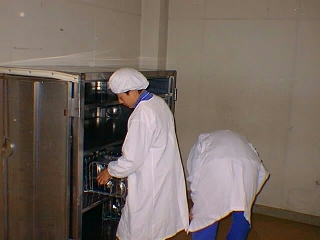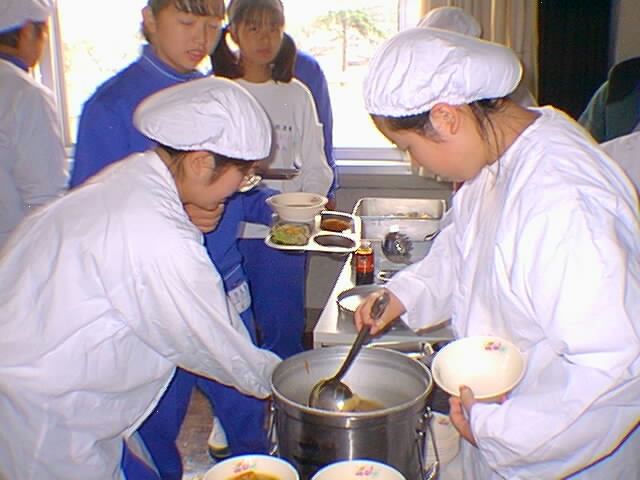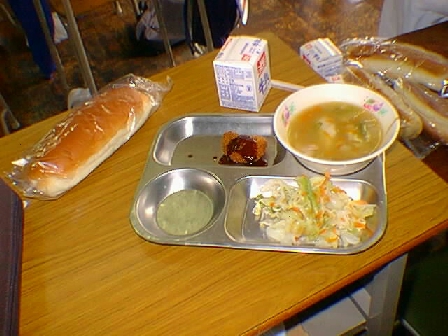School Lunch
And Other Hazards
So 4th period rolls past. It's now 12:40 and time to grab some
lunch. Well, in Japanese schools things work a little differently
than back home. You see, in Japanese elementary schools and junior
high schools there's no cafeteria. Instead, the students themselves
are responsible for dishing out their own school lunch (Jap kyuushoku),
by themselves, right in their own classroom.
Just a quick warning- from here on there will be a lot of pictures
to load. If you're patient and load them all completely once, you
don't have to wait next time.
For the Inexperienced User: Now would be a good time
to "Open A New Window" on your navigator, use the new window to browse
around some other sites, maybe check out some of my other stories or whatever,
and then come back to this page in a few minutes when all the pictures
have loaded. It beats just sitting there looking at a virtually blank
screen...
 Before lunch begins you'd better wash your hands. That's
a wash-basin, by the way, not a urinal.
I won't make THAT mistake again (tata-boom).
Sorry. Anyway, those blue sock-looking things hold soap.
All you have to do is rub your hands quickly against the soap-sock (like
you were making a Play-Doh snake, right?) and presto, you're ready to wash
up and eat.
Before lunch begins you'd better wash your hands. That's
a wash-basin, by the way, not a urinal.
I won't make THAT mistake again (tata-boom).
Sorry. Anyway, those blue sock-looking things hold soap.
All you have to do is rub your hands quickly against the soap-sock (like
you were making a Play-Doh snake, right?) and presto, you're ready to wash
up and eat.
 Are you on lunch duty this week? If you are, you have to
don the Apron and Hairnet that is the uniform of the Tooban (<toe-ban>
"Person on duty"- also the word for "duty" itself. These kids are
on Kyuushoku-tooban this week). Each class has about 4-6 kids on
toban. They have to grab the chopsticks, tin plates, food vats, milk
and dekai bread.
Are you on lunch duty this week? If you are, you have to
don the Apron and Hairnet that is the uniform of the Tooban (<toe-ban>
"Person on duty"- also the word for "duty" itself. These kids are
on Kyuushoku-tooban this week). Each class has about 4-6 kids on
toban. They have to grab the chopsticks, tin plates, food vats, milk
and dekai bread.

This would never fly in America. Yes, the tooban is, in fact,
dishing out food for their classmates. Actually this is different
class-to-class. In some classes, the tooban dishes out the food,
cafeteria-lady style, to the students (who wait in line). In other
classes, the students do it for themselves. In this class, it's a
mix between both the above.
 Usually one student stands up and goes to the front of the class
(how that student is chosen is beyond me- I would ask a teacher but I think
it would be much more fulfilling if I find out for myself). Often
the homeroom teachers eat with their classes, so sometimes a teacher will
just call on a student. Anyway, that student goes to the front of
the class, says Itadakimashoo*, the students say Itadakimasu,
and everyone digs in. By the way, (for the most part) all the students
wait until everyone has been served, and the toban have taken off their
aprons and served themselves, before they eat. That means that the
first person in the lunch line will most likely stare at his or her meal
for about 10-15 minutes before they can eat.
*Itadakimasu is one of those Japanese "set phrases"- it has
been bastardized into English into "let's eat", but that's not exactly
right. It comes from the verb Itadaku, which kind of translates into
"humbly receive". For all intents and purposes, saying 'Itadakimasu'
when you eat with others is like saying prayers before your meal- if you
were devoutly Amish. In other words, you say it in McDonalds, too.
And if you don't say it, Something's Probably Wrong. People don't
usually forget this simple point of politeness.
Usually one student stands up and goes to the front of the class
(how that student is chosen is beyond me- I would ask a teacher but I think
it would be much more fulfilling if I find out for myself). Often
the homeroom teachers eat with their classes, so sometimes a teacher will
just call on a student. Anyway, that student goes to the front of
the class, says Itadakimashoo*, the students say Itadakimasu,
and everyone digs in. By the way, (for the most part) all the students
wait until everyone has been served, and the toban have taken off their
aprons and served themselves, before they eat. That means that the
first person in the lunch line will most likely stare at his or her meal
for about 10-15 minutes before they can eat.
*Itadakimasu is one of those Japanese "set phrases"- it has
been bastardized into English into "let's eat", but that's not exactly
right. It comes from the verb Itadaku, which kind of translates into
"humbly receive". For all intents and purposes, saying 'Itadakimasu'
when you eat with others is like saying prayers before your meal- if you
were devoutly Amish. In other words, you say it in McDonalds, too.
And if you don't say it, Something's Probably Wrong. People don't
usually forget this simple point of politeness.
Itadakimashoo is like saying, "Let's Itadakimasu".
After you are finished eating, you say gochisoosama-deshita,
or simply gochisoosama if you are with friends. You say
it to your host, if there is one; the waitress and maitre 'd if you're
out (also could mean here "I'm ready to pay now"); as well as anyone you
are eating with after your last bite. It's just another one of those
Japanese set phrases. Gochisoo means "good feast". So it's
like saying "it was a good feast". Not saying it is like standing
on the table and voiding on the host.
 Oh- and about that "And Other Hazards" subline- just a joke. To be
honest, the school lunch here isn't that bad at all. Actually, in
many ways (that I can't often put my finger on) Japanese school lunch reminds
me a lot of the school lunch from the States. Here's my meal today.
It looks like your average Japanese schhol lunch faire. We have all
the major cafeteria-standard food groups covered: the Milk group, the UnLettuce
saladoid, the Soup of Some Sort, the entree (here we have croquettes with
sauce <in Japan, "sauce" usually refers to a thick sort of Wostershire
sauce that is often used, the Japanese equivallent of catsup>), and of
course the traditional Japanese Huge-Ass Loaf of Bread in Plastic. The
bread itself is a little sweet, and although it makes your mouth dry, can
be eaten without jelly or butter. There is this huge-ass (in Japanese,
"huge-ass" is dekai, hence the above reference to dekai bread.
My own word combination. Makes the kids laugh) loaf of bread every
day- I think it is for the kids who don't get filled up by the average-sized
lunch. Finish that bread and you won't even think twice about seconds.
Maybe once a week we get strawberry or blueberry jelly packets (or margerine)
to make it go down easier.
Oh- and about that "And Other Hazards" subline- just a joke. To be
honest, the school lunch here isn't that bad at all. Actually, in
many ways (that I can't often put my finger on) Japanese school lunch reminds
me a lot of the school lunch from the States. Here's my meal today.
It looks like your average Japanese schhol lunch faire. We have all
the major cafeteria-standard food groups covered: the Milk group, the UnLettuce
saladoid, the Soup of Some Sort, the entree (here we have croquettes with
sauce <in Japan, "sauce" usually refers to a thick sort of Wostershire
sauce that is often used, the Japanese equivallent of catsup>), and of
course the traditional Japanese Huge-Ass Loaf of Bread in Plastic. The
bread itself is a little sweet, and although it makes your mouth dry, can
be eaten without jelly or butter. There is this huge-ass (in Japanese,
"huge-ass" is dekai, hence the above reference to dekai bread.
My own word combination. Makes the kids laugh) loaf of bread every
day- I think it is for the kids who don't get filled up by the average-sized
lunch. Finish that bread and you won't even think twice about seconds.
Maybe once a week we get strawberry or blueberry jelly packets (or margerine)
to make it go down easier.
About half the time the lunch consists of a bowl of rice, often unseasoned,
to eat with the entree if the entree is of the kind that is usually eaten
with rice (squid tempura, etc). If there's a soup, large entree AND
a giant flavorless rice-bowl, sometimes there is no bread. Sometimes.
Sometimes we are given bread on those days, which nobody could possibly
eat after that rice save for the boys on the Judo team, who really put
it away.
Most of the wrapped foods, like the bread and jelly, or packets of seaweed
or Other Things (sometimes offered) find their way to the teacher's room
after lunch (the students bring up the leftovers). If the teachers
don't eat them, I think they might head back to the Kyuushoku-sentaa (that's
Japanese for "center") for Reprocessing. Sometimes the teachers stock
stuff in the fridge.
Anyway, one of these days I swear I'm going to take a picture of the
break-table after lunch, when there's this huge Ziggurat composed of that
bread, and put it right here. Stay tuned.
Oh, forgot to mention- there's no dessert or soda offered for lunch.
Ever.





